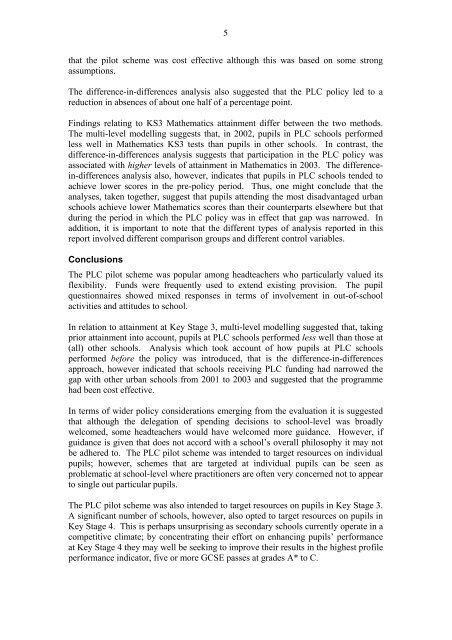Final Report of the Evaluation of the Pupil Learning Credits Pilot ...
Final Report of the Evaluation of the Pupil Learning Credits Pilot ...
Final Report of the Evaluation of the Pupil Learning Credits Pilot ...
You also want an ePaper? Increase the reach of your titles
YUMPU automatically turns print PDFs into web optimized ePapers that Google loves.
5<br />
that <strong>the</strong> pilot scheme was cost effective although this was based on some strong<br />
assumptions.<br />
The difference-in-differences analysis also suggested that <strong>the</strong> PLC policy led to a<br />
reduction in absences <strong>of</strong> about one half <strong>of</strong> a percentage point.<br />
Findings relating to KS3 Ma<strong>the</strong>matics attainment differ between <strong>the</strong> two methods.<br />
The multi-level modelling suggests that, in 2002, pupils in PLC schools performed<br />
less well in Ma<strong>the</strong>matics KS3 tests than pupils in o<strong>the</strong>r schools. In contrast, <strong>the</strong><br />
difference-in-differences analysis suggests that participation in <strong>the</strong> PLC policy was<br />
associated with higher levels <strong>of</strong> attainment in Ma<strong>the</strong>matics in 2003. The differencein-differences<br />
analysis also, however, indicates that pupils in PLC schools tended to<br />
achieve lower scores in <strong>the</strong> pre-policy period. Thus, one might conclude that <strong>the</strong><br />
analyses, taken toge<strong>the</strong>r, suggest that pupils attending <strong>the</strong> most disadvantaged urban<br />
schools achieve lower Ma<strong>the</strong>matics scores than <strong>the</strong>ir counterparts elsewhere but that<br />
during <strong>the</strong> period in which <strong>the</strong> PLC policy was in effect that gap was narrowed. In<br />
addition, it is important to note that <strong>the</strong> different types <strong>of</strong> analysis reported in this<br />
report involved different comparison groups and different control variables.<br />
Conclusions<br />
The PLC pilot scheme was popular among headteachers who particularly valued its<br />
flexibility. Funds were frequently used to extend existing provision. The pupil<br />
questionnaires showed mixed responses in terms <strong>of</strong> involvement in out-<strong>of</strong>-school<br />
activities and attitudes to school.<br />
In relation to attainment at Key Stage 3, multi-level modelling suggested that, taking<br />
prior attainment into account, pupils at PLC schools performed less well than those at<br />
(all) o<strong>the</strong>r schools. Analysis which took account <strong>of</strong> how pupils at PLC schools<br />
performed before <strong>the</strong> policy was introduced, that is <strong>the</strong> difference-in-differences<br />
approach, however indicated that schools receiving PLC funding had narrowed <strong>the</strong><br />
gap with o<strong>the</strong>r urban schools from 2001 to 2003 and suggested that <strong>the</strong> programme<br />
had been cost effective.<br />
In terms <strong>of</strong> wider policy considerations emerging from <strong>the</strong> evaluation it is suggested<br />
that although <strong>the</strong> delegation <strong>of</strong> spending decisions to school-level was broadly<br />
welcomed, some headteachers would have welcomed more guidance. However, if<br />
guidance is given that does not accord with a school’s overall philosophy it may not<br />
be adhered to. The PLC pilot scheme was intended to target resources on individual<br />
pupils; however, schemes that are targeted at individual pupils can be seen as<br />
problematic at school-level where practitioners are <strong>of</strong>ten very concerned not to appear<br />
to single out particular pupils.<br />
The PLC pilot scheme was also intended to target resources on pupils in Key Stage 3.<br />
A significant number <strong>of</strong> schools, however, also opted to target resources on pupils in<br />
Key Stage 4. This is perhaps unsurprising as secondary schools currently operate in a<br />
competitive climate; by concentrating <strong>the</strong>ir effort on enhancing pupils’ performance<br />
at Key Stage 4 <strong>the</strong>y may well be seeking to improve <strong>the</strong>ir results in <strong>the</strong> highest pr<strong>of</strong>ile<br />
performance indicator, five or more GCSE passes at grades A* to C.

















